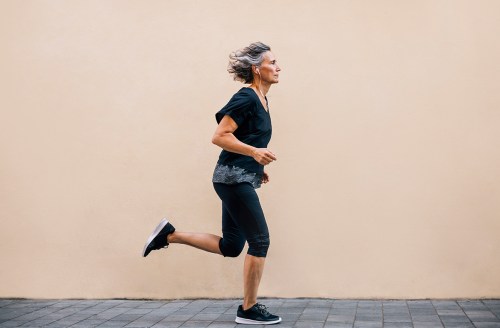Despite what you may see on Instagram, an exercise doesn’t have to be complicated to be beneficial. Such is the case with butt kicks, a plyometric (i.e. jump training) move often used as a dynamic stretch during a warm-up to activate the muscles in the posterior chain (backside of your body). “They’re great for our calves, quads, hamstrings, and glutes,” says Sarah Apgar, former all-American rugby player and founder and CEO of FitFighter. “I also like that this quick-twitch [muscle] motion requires core stability and good form with upper-body movement.”
Experts in This Article
Sarah Apgar is a fitness trainer and the founder of FitFighter.
The benefits of butt kicks
Butt kicks stretch the front of your thighs (also known as your quads), while training the back of your thighs (or hamstrings) to quickly contract—a movement pattern that’s integral to proper running form. Additionally, butt kicks will elevate your heart rate, preparing your system for cardio training.
When done properly, they can also help to increase joint strength and mobility in your ankles, knees, and hips. Furthermore, research has found that plyometric exercises are a vital part of injury prevention when combined with stabilization and balance exercises.
How to do butt kicks
At its core, butt kicks are simply jogging (either in place or forward) while trying to touch your glute with your heel with every lift of a foot, hence the name. There is some fine-tuning that should be done, however, to make sure you have proper form and get the most out of the exercise.
Apgar notes that these are the keys to good form on butt kicks:
- 1.Push squarely off the balls of your feet with your torso upright, so that you’re using your calves and powerful lower body muscles.
- 2.Squeeze your belly button to your spine to keep your spine stable and supported.
- 3.Contract your hamstring tightly as you kick one heel up toward your glute; use a powerful and deliberate swing with your arms (like you’re running).
- 4.Rinse and repeat back and forth from one leg to the next quickly, but with control.
If you’ve mastered the move and want to make it harder, Apgar notes you can modify butt kicks by holding a light weight—she recommends five pounds. “This will now increase [rotation] of the trunk and require even greater stability to be maintained,” she notes. Translation: It’ll mean more work for your core, especially your obliques, which are responsible for twisting your midsection from side to side.
How to add butt kicks to your routine
If you want to combine butt kicks with other plyometrics exercises for a high-intensity, high-impact cardio workout, Apgar suggests adding high knees and tuck jump movements to get opposing muscle groups worked during your conditioning.
Squat jumps are another OG plyo move, here’s how to do them the right way:
Oh hi! You look like someone who loves free workouts, discounts for cutting-edge wellness brands, and exclusive Well+Good content. Sign up for Well+, our online community of wellness insiders, and unlock your rewards instantly.
Sign Up for Our Daily Newsletter
Get all the latest in wellness, trends, food, fitness, beauty, and more delivered right to your inbox.
Got it, you've been added to our email list.











